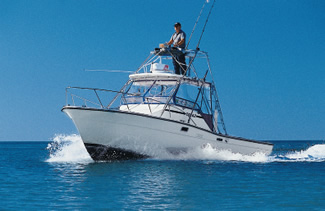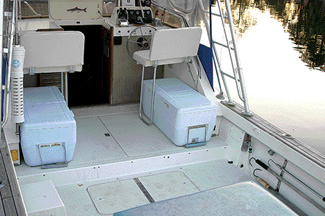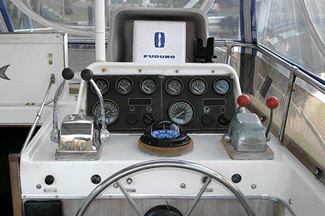February 15, 2013
By Florida Sportsman
This 28-foot dreamboat showcases everything it takes to tackle the spring cobia run.

Teaser is outfitted with everything for cobia action--and nothing extra to get in the way.
|
Bob Nichols and his 28-foot Teaser are a dangerous combination for Panhandle cobia. Not that his boat is loaded with an array of “can't-miss” fishing gizmos; on the contrary, said Nichols, “the best way to catch cobia is to keep it simple.”
He should know. He's been fishing the cobia migration along Panama City Beach for 45 years. It's a passion he discovered while stationed at nearby Tyndall Air Force Base in the 1950s.
“I just couldn't shake it; it got under my skin,” he recalled. “Of course, back then you only fished off the piers. For someone to have a boat was a rarity.”
Over that time Nichols has caught 18 cobia that crested 90 pounds, and thousands of smaller versions. He also went through half a dozen boats, but after spotting a 28-foot Topaz more than 18 years ago, nothing else would do.
Manufactured and rigged in 1979 for offshore sportfishing, much of what makes the Teaser the perfect cobia hunter today was built into the original design. Nichols was impressed by the 101/2-foot beam, the wide tower with controls, and just the way it looked on the water.
“If you look at it from the side it has a gorgeous sheer,” he noted.
The Panhandle cobia migration takes place every spring, with a peak some time in April. During those weeks, cobia of all sizes follow an ages-old, east-to-west migration route along the white sand beaches of the Florida Panhandle.
Anglers from Panama City to Pensacola scout for pods of the fish in the clear Gulf waters. The basic approach is to cruise in the same direction of the migration at a speed just fast enough to overtake the fish, or in the opposite direction as slow as you can move. Boats have to be small enough to work in close, but big enough to handle the seas, and sometimes the surf.
Nichols added a set of trim tabs to the Teaser to help in the battle against heavy chop.
“What happens is you decide to fish all the way to Destin, about 50 miles. You go out in the morning and the forecast is calling for 10 to 15 knots. Then they start upgrading to 15 to 20 knots, but you're just cruising along to the west with a southeast wind—a great wind for cobia—but a tough wind to get home against.”
Drawing only 2 1/2 feet, Teaser runs shallow enough to work in close.
“The majority of the cobia anglers out of Destin catch the fish in deeper waters a half mile to a mile offshore, but near Panama City they run much closer to the beach,” Nichols explained. “There are times when the fish go into the gully, between the first sandbar and the beach. When they do, I go inshore, too, but I couldn't do it with a deeper draft. The water gets pretty rough in April. A wave can go out, and the bottom drops out, and you can get in trouble real quick.”

Twin seats and coolers are easily removed for access to the engines. Chum grinder hangs from the tower on port side; gaffs under the starboard gunnel.
|
Once a fish, or its shadow, is spotted, Nichols' “keep it simple approach” comes into play. For example, since the initial cast always comes from up top, the tower has been stripped to the bare essentials.
“It came with a Bimini top and looking like a battleship with huge outriggers and spreaders,” said Nichols. “That stuff came right off and stayed off.”
He added only a pair of drop-down antennas that can be lowered from the tower.
Teaser's extra-wide tower can comfortably hold four anglers plus the boat driver. The base is nine feet above the deck, but it isn't tippy, said Nichols.
“I've been able to stay there in 6-foot seas,” he said.
He added rocket launchers to the back rail, which on a typical trip hold four, identical Penn 320 GTI conventional reels with 40-pound test and 200 yards of line. Each is rigged with a large, feathered ling jig and no leader. The lures are reeled tight to the tip of an 8-foot fiberglass rod.
The reason for 40-pound test, which may seem high, is that it avoids the use of a leader, which again, keeps it simple and minimizes the number of things that can go wrong. He has never had a cobia gnaw through the 40-pound Ande line.
The rods are the same model that Nichols has been using since 1958. At that time, they were manufactured and sold under the name “Hurricane” rods and were popular with commercial grouper fishermen. They are hollow fiberglass with triple strong stainless steel guides and a replacement oversized carbide tip. The large tip allows him to wind the eye of the 3-ounce jig through it, which snugs the lure tight to the rodtip. This keeps the lure from flopping around while in rough seas when the chase is on. A loosely secured lure can nick the line and go undiscovered until too late.
Although Hurricane rods are no longer made, the rod blank is still available as a “Gator Glass” Model T-80H. Nichols has his rods built at Half Hitch Tackle Shop in Panama City with silicon carbide guides, Fuji reel seats and cork grips fore and aft.
The rig allows for long casts if needed, the power to drive the hook home in a tough mouth, and the muscle to bring the cobia alongside the boat.
When a cobia or a pod of cobia is sighted, it takes only a couple seconds for one or more anglers to pick up the nearest rig, push the release, and snap out a cast in one continuous motion. Multiple hookups are more common from the wide tower because there's room for additional anglers to get in on the action.
For those long trips to Destin, Nichols also added a seat/leaning post, and a handy pair of drink holders.
In the cockpit, the two individual seats are m
ounted on an aluminum bar attached to the gunnel so they can swing out of the way for access to the engines. That setup inspired Nichols to add two 178-quart Gott/Rubbermaid coolers for dry storage and easy access. Teak stops keep them in place and they can be easily moved to service the engines.

She's a twin-screw diesel, with the ability to spin on a dime. Nichols believes that offers a distinct advantage in addressing oncoming fish.
|
The coolers hold things like billy clubs, buckets, marker buoys, a baitwell dip net, a cutting board and small hand gaffs, if needed, for handling and releasing undersized fish with minimal damage. Most of the items in the cooler are the kind that can get in the way at the worse times, or that need to be found immediately.
The coolers, like many of Nichols' little tweaks, have a second use. In this case it's as a much appreciated first step up to the tower ladders on either side. The same thing is true on the climb down when transferring to the back deck to fight a fish.
He also redesigned the driver's seat to serve double duty as a leaning post so he can stand and scout the water even when conditions require driving from the lower deck. He simply added a 6-inch-high board that runs the length of the front of the seat and attaches below the seating surface. Once assembled and reupholstered, it provides a leaning post/seat combination. “No self-respecting cobia fisherman can sit while the search is on and the leaning post greatly reduces leg strain,” explained Nichols.
Even when driving from the cockpit, Nichols still scans for fish.
“Topaz was among the first boats built without a windshield, but with a raised Plexiglas lip that goes around at the base of where the windshield would be. The result is an open-air ride and clear visibility.”
In bad weather you can zip in the plastic and seal the cockpit.
A set of drink holders he mounted next to the passenger serves double duty as a display rack for a variety of ready-to-use ling jigs. He also added a tool holder for pliers and keeps gloves in a small open compartment just below. The final cockpit addition is a pair of spreader lights overhead that light up the back deck when necessary.
Electronics rarely come into play during spring cobia fishing, but for those occasional offshore trips Nichols carries two of everything—including GPS units, bottom machines and VHF radios. The idea, as he put it, is to “never have a bad day on the water because of equipment failure.”
On the wide-open back deck the original fighting chair went the way of the outriggers 18 years ago and was moved “to a permanent spot in the garage.” In its place Nichols built and installed a large multi-purpose fish box with a padded top. The box serves as a padded seat for weary anglers, a table, a lounge chair for sunbathing and a pretty good place to take a nap. But its primary purpose is to safely receive a 60- to 90-pound fish straight from the water without it dropping on the deck.
Cobia are incredibly strong, and a fish loose on the deck can create some serious havoc, especially if one or two other anglers are still fighting fish. Sixty pounds of muscle flopping around and sliming the deck can knock you right off your feet.
Smaller fish can be held next to the box for a quick comparison to the 33-inch rule painted on the edge.
Handmade gaffs (always at least two) are stored under the gunnel where Nichols has installed enlarged holders for his oversized handles. The handles are made out of 11/2-inch round pine stock, available in most hardware stores. The hooks are 5/0 Mustad Gaff Hooks, Model 2286TD—cadmium plated steel. Nichols usually cuts the handle to a 5- to 6-foot length. He cuts a slot for the hook and wraps it snugly with parachute chord. He then applies an epoxy sealer over the wrap.
Once gaffed, a big cobia will twist with unexpected force. “It's essential,” said Nichols, “that you stop the twisting action. A firm grip, made possible by the oversized wooden handle, which is easier to hold on to even when wet, can save the day.”
Nichols also advises that all gaffing be done from under the fish with the gaff point up. The gaffer needs to be well braced, and should sink the hook, quickly. Then move one hand down the handle to get good leverage and lift fish smoothly over the gunnel and into the box, all in one motion—never letting the hook twist or stopping to rest on the way.
He also added a 30-gallon livewell, again out of the way between the fish box and the stern. When using eels for bait, he pulls out a small lunch cooler, which he sets near the stern. He puts in a layer of ice and on top of that places an eel already hooked on a large spinning rod. The rod sits in a holder on the back side of the tower.
When a fish is spotted, a quick jerk on the rod pops the cooler lid open and the eel comes sailing out, ready to cast.
The cabin, which is designed to sleep two, has little to do with cobia fishing, but it “has wonderful dry storage under the bunks and in the anchor locker,” said Nichols. There's also a complete cooking facility and a refrigerator. But lunch is about the only thing that gets made, and only because sandwiches are easy to eat in the tower.
Below decks, the original 125-hp Volvo engines were replaced 18 years ago by a pair of 165-hp 6-cylinder Volvo diesels that still run clean and smooth. They give Teaser a top end of about 22 knots.
Because of maneuverability, twin engines are another cobia-catching asset, explained Nichols, especially during the return trip from the west when you meet the migrating cobia head on. When Nichols spots a fish passing off to one side, he can drop into neutral, throw one engine into reverse and the other forward so the boat pivots within its own length following the direction of the fish.
“That way, I don't have to take my eye off the fish for even one second.”
Swinging around in a wide arc with a single engine makes it almost impossible to keep the fish in sight and is hardly worth the effort. Also, with the diesels, there's a whole lot less noise when you turn on a fish, whereas the cavitations and racket of an outboard can easily send them off.
In fact, Nichols is sure the diesels give him a major advantage because their sound seems to attract cobia, or at least gets their attention. His theory is that the fish are already well-accustomed to associating the sound of diesels in shrimpboats with a feeding opportunity. And when you consider the hundreds of shrimpers they're likely to encounter during their annual migrations to and from the southern Gulf, it makes some sense.
“Sometimes when the cobia are moving along close to the bottom and are hard to see, the engine noise seems to bring them up to the surface for a look. The nice mellow sound of a diesel, as compared to an outboard, also doesn't spook the fish when you overtake them.”
When moving back east, against the direction the fish are moving, Nichols has also noticed more fish coming straight at the boat then passing on either side, as if they change direction and zero in on the noise.
“Sometimes we see four or five cobia at a time moving right dead on the bow—homing in on the same line we're traveling.”
Now that's a boat that can help your fishing.
FS
First Published Florida Sportsman March 2004
